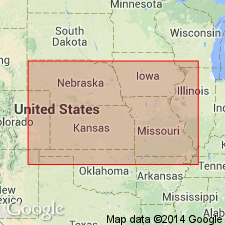
- Usage in publication:
-
- Wyandotte limestone
- Modifications:
-
- Overview
- AAPG geologic province:
-
- Forest City basin
Summary:
Pg. 85, 91, 92, 97. Wyandotte limestone. Basal formation of Lansing group. Includes "Iola" limestone of Kansas City area (which is now named Argentine), a few feet of overlying shale (here called Island Creek shale), and, at top, Farley limestone. At base of the Argentine at some exposures are a very dark or black fissile shale (Quindaro) and blue dense limestone (Frisbie). The Wyandotte includes a complete cycle except for the "lower" limestone and shale. It is very prominent in Wyandotte County and along Kansas River, but becomes thinner southward and disappears in Miami County, Kansas. Overlies Lane shale and underlies Bonner Springs shale. Age is Late Pennsylvanian (Missouri age). [On p. 47 is a detailed section of Wyandotte limestone aggregating 59 feet.]
Source: US geologic names lexicon (USGS Bull. 896, p. 2376); GNC KS-NE Pennsylvanian Corr. Chart, sheet 2, Oct. 1936.
For more information, please contact Nancy Stamm, Geologic Names Committee Secretary.
Asterisk (*) indicates published by U.S. Geological Survey authors.
"No current usage" (†) implies that a name has been abandoned or has fallen into disuse. Former usage and, if known, replacement name given in parentheses ( ).
Slash (/) indicates name conflicts with nomenclatural guidelines (CSN, 1933; ACSN, 1961, 1970; NACSN, 1983, 2005, 2021). May be explained within brackets ([ ]).

